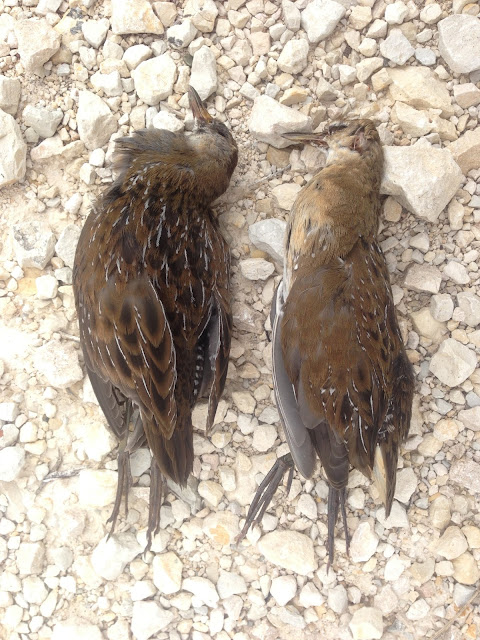Why?
How?
...and often enough, the answers are simple.
Humans.
Birds have been documented at lighthouses - fluttering, trapped in the beam of light - since the 1800s.
Artificial light causes birds to become disoriented.
Glass is not a new technology. Prior to WWII, large panes of glass were expensive and of questionable clarity/quality. The following industrial boom, however, made sheet glass commonplace in architecture.
There's nothing like it in nature.
Wind turbine technology went from the literal wind mill - for milling grain into flour, using broad, wooden, canvas, or metal blades - into 10x the height, 8x the width, and speeds ranging well into 100 mph range.
There has been no coevolution with this technology.
Cell towers have wires to anchor them. Power lines. Same story as above, but this time, a little closer to home.
Oversimplified? Very. But it does matter. Because there is no need for this:
 |
| Sora (Porzana carolina), power line kills, Brewster County, TX 17 Sept. 2013 - photo by Matt York |
It is important to note - in all things - that birds are not helicopters. Hummingbirds are close to being an exception, but they are by far the outliers. Especially around water, where large, heavy-bodied birds are regularly traveling, it is hazardous to have power lines, cell towers, wind turbines, or large windows: even small, lightweight birds heading to or from the water need air space for takeoff and landing. Some airports are wedged into narrow corridors, but engineers would never dream of having massive aircraft land or takeoff from a runway boxed in at the ends by huge obstacles. The differences is that birds simply cannot perceive the obstacles and have no civil engineer to plan their routes. Since the dawn of their migratory patterns, changes in their habitats have been gradual. Only in a relatively short amount of time (it's all relative) have humans significantly, and quickly, altered their migration habitats in ways that are drastically different from year to year.
 |
| Sora (Porzana carolina), power line kill, with Sibley's Western Guide, Brewster County, TX 17 Sept. 2013 - photo by Matt York |
We are within the winter range for Sora; what we lack is habitat, and observable habitat. My only previous sighting for Brewster County was 23 October 2011, at Post Park. If my memory serves, it was an adult. These two, as illustrated in Sibley's book, were in the buffiness of youth. Juvenile plumage. Subtle coloration that matched the grass. These two were within 20, perhaps 15 feet of each other. An overcast morning, following an overcast evening after an overcast day. What are the odds? No, really. What are they? Sora are well documented as window kills throughout North America (Chicago, Toronto, NY, you name it - even Stillwater, Oklahoma) but to have two that apparently struck at the same time... were there 2 Sora? And both hit? Were there more? Was it 2 of 10? Surely 10 is too high a number - they're not particularly flocking creatures - but what do we know?
Two sora, three power lines, and a curiosity for what will be found in the future.
"I don't need a weapon! My friends are my power!" —Sora
If only.
...if only.
* These two birds will go to the collections at Texas A&M University, per our permits. Call it science.

No comments:
Post a Comment